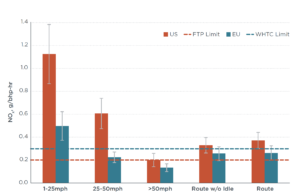There is a significant gap between real-world and certified NOx emissions from heavy-duty diesel vehicles. This gap is especially wide during urban driving conditions and other low-load operations in diesel HDVs certified under the US EPA 2010 program. A new ICCT-report compares NOx emission values from 11 HDVs designed to meet the EPA 2010 NOx standard with five European trucks designed to meet the Euro VI NOx standard.
The analysis by ICCT finds that European HDVs are better designed than US trucks to control NOx emissions under low-speed, low-load, and idle conditions. The US HDVs studied emit on average 1.4 times more NOx per unit work than the European vehicles.
During urban driving conditions, work-specific NOx emissions of US HDVs almost quadruple in magnitude compared to their total route emissions. For European HDVs urban driving emissions were twice as much as their total route emission values. US trucks emit more NOx than the European trucks at the lowest power range, including idle. Below 10% of maximum rated power, the sample of US trucks emits twice as much NOx as the sample of European trucks studied.
The report also analyzes the tools used in each program for analyzing PEMS data and determining in-use emissions compliance. The analysis of the in-use compliance tools, US. Not-to-Exceed (NTE), and the European moving average window (MAW) protocols, indicates that excluding data from the regulatory evaluation directly impacts in-use NOx emission values. The US NTE protocol evaluates in-use NOx data only under a narrow band of vehicle operating conditions, exclusively during highway driving. In contrast, the European MAW method for in-use compliance evaluation better captures NOx emissions at low-speed and low-power demands that are characteristic of urban driving.
Modifying the US NTE protocol to include more data for compliance evaluation would not address the high level of emissions captured under urban driving conditions. Improvements could also be made to the MAW protocol to further incentivize urban NOx reductions, including expanding window validity to all power conditions.
Source: ICCT

